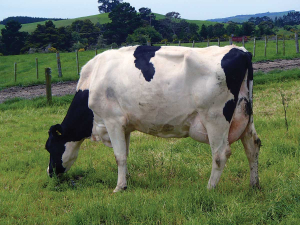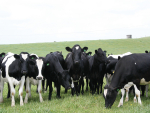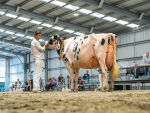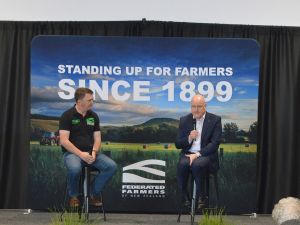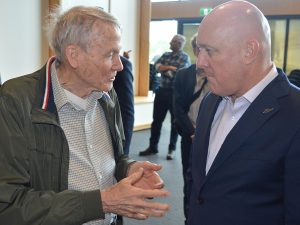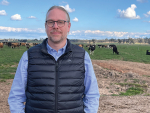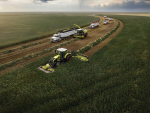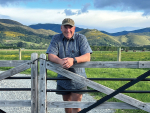On the edge of the hot, dry Takapau plains, Norm and Del Atkins have cultivated a small but exceptional herd of 60 Holstein Friesian cows within their mixed breed herd of 360 dairy cows.
The herd, which also includes Jerseys, Ayrshires and Milking Shorthorns, produces 1,100kgMS/ha, with a stocking rate of 2.9cows/ha on 30% hill country.
Despite the Holstein Friesians leading the way for milk volume, Norm is very clear that he doesn’t have a favourite breed of cattle.
“All breeds have their strengths and weaknesses, and it’s our job to improve them for our environment,” he says. “My favourite cows are high producing, regular breeders, classifying 8-9 or 9-8.”
Norm’s journey into dairy farming is deeply rooted in his family’s history. His father emigrated from England to Australia at 15, undertaking farm and building work for four years before coming to New Zealand in 1924 to train at Massey College as one of the first herd testers.
He met Norm’s mother on a dairy farm outside of Whanganui, and he trained the first women herd testers before he went into service in WWII.
After he returned, they moved their young family to a rough, gorsy 40 acre block outside of Whanganui.
“Dad worked in town, but we cleared enough land to milk 20 cows for cream, and have pigs,” Norm says.
He says as a schoolboy, and later as a Massey Agricultural Science student, he willingly helped his mother and father on the farm and developed a passion for cows and land development. He continued to follow in his father’s footsteps and trained as a herd tester and AI technician, developing a keen interest in breeding along the way.
In 1978 the family sold the property, Norm’s Mum and Dad semi-retired and the family moved to Turakina.
They had bought 100 acres of crown lease land – a rehab farm – and milked 80 cows of mixed breed after recommissioning the old cow shed.
It was during this time that the first Holstein Friesians came on board.
Norm met Del, a nurse from Sydney, through a friend when she was visiting her sister nearby. They married in 1983, and bought the farm from Norm’s parents, which they were required to freehold under the Lange/Douglas government.
They bought another property in the Turakina Valley, but when interest rates reached 25% things became tough financially.
“Del worked 11pm-7am as a midwife, got our boys ready for school and then came down to the shed with me,” Norm recalls. “It was the only way we could cope with the debt load. It was three years before interest rates decreased to 12%.”
Norm says the Edenmore herd has foundations in several excellent cow families. His first pedigree Holstein Friesian was sired by Hanover-Hill Inspiration and from the Mahoe Northern Leyma/Tahora Linmack Leyma family.
“Today, our best families are our Tui/Huias,” he says. “We also have many descendants from Manganui Justin Pearl, having bought four from this family at the Pukeatua Dispersal at Toko. Our Seagulls graded up from a very good Gerris cow, and we also have a number of Storms from a Maughlin Storm cow. The Valden Theo family is also doing well.”
In 2004, once their two sons had finished high school, Norm and Del sold the Turakina farm and moved to Makotuku to grow the business.
“They were brought up to be farm boys, but although vitally interested trustees, they have not ended up hands-on farmers,” Norm says.
Until 2020, Norm was farming 700ha of drystock and dairy at Makotuku. He has since reduced his farming operation to 430ha, and focused on the mainstay dairy farm and herd of 360 cows.
He has a winter milk contract so the herd split calves, with autumn calving beginning March 20; 50-60 replacements are kept, and all Holstein Friesian and Milking Shorthorn bulls are reared.
The herd has been on a once-a-day (OAD) milking schedule for five seasons.
“Twice a day milking was too labour-intensive, particularly when we were short on staff,” Norm says.
The Holstein Friesians are higher volume cows than the rest of the breeds, producing 286kgMS/cow over 170 days, at a stocking rate of three cows per hectare.
Their ability to handle OAD milking – thanks to their good udders and strong ligaments – has impressed Norm.
“The mature cows chug along quite nicely on OAD,” Norm says. “We are doing alright, but we could be doing better. We grow maize on the drystock country, so we do have the option to increase their supplementary feed.”
Now, with three full-time staff, Norm is reconsidering the future of OAD on the farm.
Farm Facts
- Owners: Norm and Del Atkins
- Location: Norsewood, Tararua
- Farm size: 430ha (120ha milking platform)
- Cows: 360 (60 registered Holstein Friesians)
- Production: 132,000kgMS
- Stud name: Edenmore

